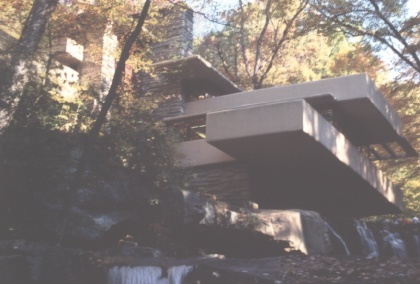| Frank Lloyd Wright's "Fallingwater" | |||
|
But McCarter says it better than I can, "We cross the bridge and turn left, where the concrete trellis over the drive curves dramatically in two places in order to go around the trunks of trees close to the walls of the house. An opening between the layered rock walls to the left lets us into a loggia; ahead is the front door, made like the windows of glass set in red steel frames, deeply recessed between rock walls, a concrete-slab header forming a low ceiling over the entrance (Frank Lloyd Wright often compressed you in his entrances, so that as you stepped away and into the room beyond, it seemed much larger than it was). Opening the door we move into a small foyer; before mounting the three stairs up to the living room floor, we note that from the level of this lower foyer, our eye level is almost exactly at the center of the space between floor and ceiling. From this perspective, the living room seems to open out in all directions, so that upon passing through the small cave-like entrance, we find, much to our surprise, that we can look out to the trees on all sides... "Drawn towards the sound of the waterfall, we walk across the living room and open the glass doors, moving out on to the terrace cantilevered out over the waterfall. Looking out into the trees, the sound of the waterfall now surrounds us and we seem to be a part of it, having been projected out into space directly above it. At this moment we recognize Wright's intention in placing the house where he did: rather than present the waterfall as an object to be looked at, he allows us to feel as if we are part of it, hearing it and sensing it, but rarely seeing it from within the house." I like what McCarter says here, "This feeling of being suspended over the waterfall is reinforced as we are drawn back into the living room towards the bright light coming from the trellis skylights opened in the concrete roof directly ahead; under these a low glass-enclosed 'hatch' opens to a concrete stair descending to the stream below. |
The dark gray color of the bedrock ledge under the shallow water, and the way light is reflected from the rippling surface of the stream, are matched exactly by the gray flagstone floor upon which we stand. Seen through the hatch, the suspended stairs oppose the flow of the water in the stream, and the movement down to the water is balanced by the skylight and trellis openings to the sky above. Descending to the stream below, we hover only inches above the water, facing away from the waterfall, hearing its roar behind us, magnified by the hard underside of the living room's enormous cantilevered floor slab that floats over our heads." So my son and myself, with a friend, toured "Fallingwater." Mecca was visited, and I came away with the feeling that I had seen another of Frank Lloyd Wright's greatest buildings. I now go back to McCarter's book and quote most of his ending paragraph about "Fallingwater:" Frank Lloyd Wright's "Fallingwater appears to us to have grown out of the ground and into the light, making present the latent power of the boulder on which it sits above the waterfall--the same boulder which emerges from the rippling 'water' of the flagstone living-room floor to provide a place of stability in front of the fireplace. The natural setting is so integrated into this house that in occupying it we are constantly reminded of where we are by the sound of the waterfall, the flow of space and movement inside and outside across the floors and terraces, and the fire burning deep in the bedrock masonry of the house giving a strong sense of refuge; the views and sunlight are framed by the steel windows, which act as spatial 'nets' or 'webs'. The whole provides a true sense of shelter, combining the attributes of refuge and outlook." "Fallingwater", certainly one of the greatest buildings ever done, and the world's most influential one. |
||
 |
|||
| All Fallingwater Photographs by Nelson Brackin | |||
 |
1 2 3 4 | ||
